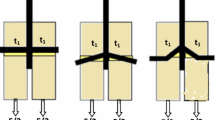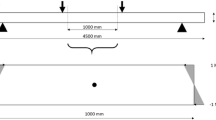Abstract
The paper presents a parametric numerical study on the splitting strength of timber beams loaded perpendicular-to-grain by dowel-type connections. The main aims of the numerical investigations are: (1) find out the influence of main connection parameters on the splitting strength of beams; (2) compare the above evaluated influences with the ones proposed by the first author in a recently developed semi-empirical prediction formula. The first part of the paper presents the mentioned new semi-empirical prediction formula which has been developed by means of a survey on experimental data from literature. The formula is presented in its main aspects and later its prediction capability is discussed and compared with the ones of formulae embodied in new European and German design codes for timber structures. The second part of the paper reports the main results of parametric numerical analyses carried out in the framework of Linear Elastic Fracture Mechanics (LEFM) by means of a crack propagation approach. The analyses are performed on beams of different size loaded at mid-span by both single and multiple dowel connections. The main investigated parameters are the connection width (l r), the connection depth (h m), and the number of rows of fasteners (n). They are analysed for different beam heights (h) and for different distances of the most distant row of fasteners from beam loaded edge (h e). The numerical results are compared with available experimental test data and with the relationships embodied in the above-mentioned semi-empirical prediction formula.
Résumé
L’article présente les résultats d’une étude numérique paramétrique qui analyse la résistance à la fissuration de poutres en bois chargées perpendiculairement aux fibres de connexions, avec des connecteurs cylindriques. Le but principal de cette étude numérique est: (1) déterminer l’influence des paramètres principaux des connexions sur la résistance à fissuration des poutres; (2) comparer les résultats obtenus avec les résultats proposés par Ballerini dans une formule récente de prédiction semi-empirique. La première partie de l’article présente la formula citée de prédiction semi-empirique développée sur base d’une analyse des données expérimentales disponibles dans le texte. La formule est illustrée dans ses aspects principaux et par la suite sa capacité prévisible est comparée avec celle des formules adoptées par les récentes normes européennes et allemandes pour les structures en bois. La seconde partie de l’article reprend les principaux résultats de l’analyse numérique paramétrique développés dans le domaine de la Mécanique de la Fracture Linéaire Elastique (LEFM) à l’aide d’analyses avec propagation de fissure. Les analyses concernent des poutres de différentes dimensions chargées en ligne de connexions avec un ou plusieurs connecteurs cylindriques. Les paramètres principaux étudiés sont la largeur (lr), la hauteur (hm) et le nombre de lignes des connecteurs (n) de la connexion. Les analyses concernaient des poutres de différentes hauteurs (h) et placés à différentes distances par rapport au bord des poutres de la ligne des connecteurs plus éloignée (he). Les résultats numériques sont comparés avec les données expérimentales disponibles et les études prévues par la formule citée de prédiction semi-empirique.
Similar content being viewed by others
References
Möhler K, Lautenschläger R (1978) ‘Large perpendicular-to-grain connections in glulam beams’, “only available in German”, Forschungsbericht des Lehrstuhls für Ingenieur-holzbau und Baukonstruktionen, Universität Karlsruhe
Möhler K, Siebert W (1980) ‘Design of perpendicular-to-grain joints for loads suspending for glulam or timber beams’, “only available in German”, Forschungsbericht des Lehrstuhls für Ingenieurholzbau und Baukonstruktionen, Universität Karlsruhe
Ehlbeck J, Görlacher R (1983)‘Structural behaviour of perpendicular-to-grain connections with steel elements in timber construction’, “only available in German”, Forschungsbericht der Versuchsanstalt für Stahl, Holz und Steine, Abt. Ingenieurholzbau, Universität Karlsruhe
Ehlbeck J, Görlacher R, Werner H (1989) ‘Determination of perpendicular-to-grain tensile stresses in joints with dowel-type fasteners: a draft proposal for design rules’, in Proceedings of CIB-W18 Conference, paper 22-7-2, Berlin, German Democratic Republic, Sept. 1989
DIN 1052:2004-08 (2004) ‘Design of timber structures—General rules and rules for buildings’, “only available in German”, (DIN, Germany, 2004)
Van der Put TACM (1990) ‘Tension perpendicular to the grain at notches and joints’, in Proceedings of CIB-W18 Conference, paper 23-10-1, Lisbon, Portugal, Sept. 1990
Van der Put TACM (1992) ‘Energy approach for fracture of joints loaded perpendicular to the grain’, in Proceedings of COST 508 Workshop on “Fracture Mechanics in wooden structures”, Bordeaux, France, April 1992
EN 1995-1-1:2004 (2004) ‘Eurocode 5 - Design of timber structures. Part 1-1: General rules and rules for buildings’, CEN/TC 250/SC5, 2004-11-01
Yasumura M, Murota T, Sakai H (1987) ‘Ultimate properties of bolted joints in glued-laminated timber’, in Proceedings of CIB-W18 Conference, paper 20-7-3, Dublin, Ireland, Sept. 1987
Yasumura M (2001) ‘Criteria for damage and failure of dowel-type joints subjected to force perpendicular-to-grain’ in Proceedings of CIB-W18 Conference, paper 34-7-9, Venice, Italy, Aug. 2001
Reske RG, Mohammad M, Quenneville JHP (2000) ‘Influence of joint configuration parameters on strength of perpendicular-to-grain bolted timber connections’, in Proceedings of 6th World Timber Engineering Conference, WCTE 2000, Whistler, B.C., Canada, Aug. 2000
Kasim M, Quenneville JHP (2002) ‘Effect of row spacing on the capacity of bolted timber connections loaded perpendicular-to-grain’, in Proceedings of CIB-W18 Conference, paper 35-7-6, Kyoto, Japan, Sept. 2002
Ballerini M (1999) ‘A new set of experimental tests on beam loaded perpendicular-to-grain by dowel-type joints’, in Proceedings of CIB-W18 Conference, paper 32-7-2, Graz, Austria, Aug. 1999
Ballerini M, Giovanella A (2003) ‘Beams transversally loaded by dowel-type joints: influence on splitting strength of beam thickness and dowel size’, in Proceedings of CIB-W18 Confe-rence, paper 36-7-7, Estes Park, Colorado, USA, Aug. 2003
Borth O, Rautenstrauch K, (2001)‘Estimation of the load-carrying capacity of perpendicular-to-grain bolted timber connections by fracture criterion in the framework of LEFM’, in Proceedings of the International RILEM Symposium on “Joints in Timber Structures”, Stuttgart, Germany, Sept. 2001
Ballerini M, Bezzi R (2001) ‘Numerical LEFM analyses for the evaluation of failure loads of beams loaded perpendicular-to-grain by single-dowel connections’, in Proceedings of CIB-W18 Conference, paper 34-7-6, Venice, Italy, Aug. 2001
Acler W (2002) ‘A numerical study on the splitting strength of beams loaded perpendicular-to-grain by single-dowel connections: influence of geometrical and mechanical parameters’, “only available in Italian”, Degree Thesis, University of Trento, Italy, Oct. 2002
Ballerini M (2004) ‘A new prediction formula for the splitting strength of beams loaded by dowel-type connections’, in Proceedings of CIB-W18 Conference, paper 37-7-5, Edinburgh, Scotland, Aug. 2004
Wu EM (1967) ‘Application of fracture mechanics to anisotropic plates’. ASME J Appl Mech Series E 34(4):967–974
Chen LS, Kuang JH (1993) ‘A displacement extrapolation method for two-dimensional mixed-mode crack problems’. Eng Frac Mech 46(5):735–741
Guinea GV, Planas J, Elices M (2000) ‘KI evaluation by the displacement extrapolation technique’. Eng Frac Mech 66:243–255
Hunt DG, Croager WP (1982) ‘Mode II fracture toughness of wood measured by a mixed mode test method’. J Mater Sci Lett 1(1):77–79
Valentin GH, Boström L, Gustafsson PJ, Ranta-Maunus A, Gowda S (1991) ‘Application of fracture mechanics to timber structures, RILEM state-of-the-art-report’, VTT – Technical Research Centre of Finland, Research Notes 1262, Espoo, Finland, 1991
Tan DM, Stanzl-Tschegg SE, Tschegg EK (1995) ‘Models of wood fracture in mode I and mode II’. Holz als Roh-und Werkstoff 53(3):159–164
Author information
Authors and Affiliations
Corresponding author
Rights and permissions
About this article
Cite this article
Ballerini, M., Rizzi, M. Numerical analyses for the prediction of the splitting strength of beams loaded perpendicular-to-grain by dowel-type connections. Mater Struct 40, 139–149 (2007). https://doi.org/10.1617/s11527-006-9156-2
Received:
Accepted:
Published:
Issue Date:
DOI: https://doi.org/10.1617/s11527-006-9156-2




